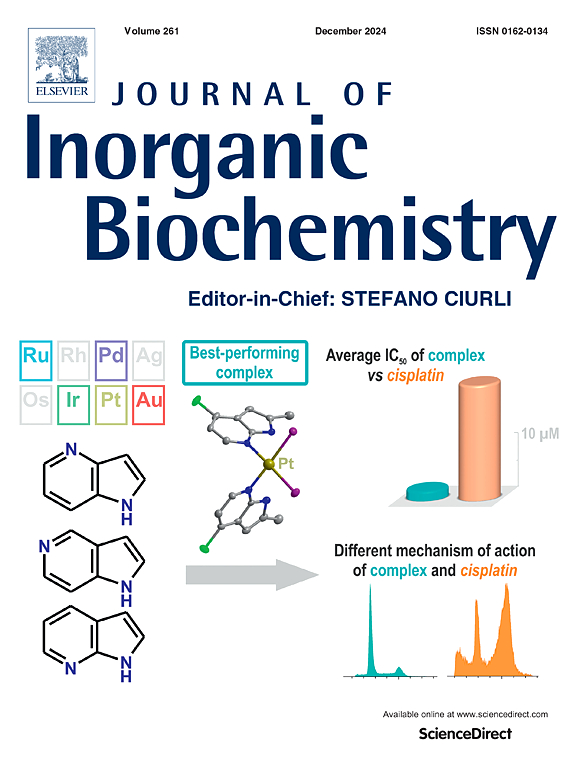Evaluating indole‑gold(I) based complexes as potential anti lymphoma agents by disrupting the thioredoxin reductase/glutathione peroxidase axis
IF 3.2
2区 化学
Q2 BIOCHEMISTRY & MOLECULAR BIOLOGY
引用次数: 0
Abstract
Antioxidant systems, especially the thioredoxin (Trx) and glutathione (GSH) systems, represent promising targets for cancer therapy. Overexpression of these systems has been reported in many cancers, including lymphoma and considered as a mechanism of protection for cancer cells from the high levels of reactive oxygen species (ROS). Over several decades, metal-based complexes including gold complexes such as auranofin have shown anticancer activity by targeting thiols and selenol groups in the active site of thioredoxin reductase (TrxR). However, lack of selectivity, severe side effects or resistance to therapy have been widely reported. Recently, glutathione peroxidase (Gpx) has been reported as one of the key proteins that regulate ferroptosis in cells. To expand the armory for targeting antioxidant systems, in this study eleven new indole-metal complexes were synthesized and assessed for their antiproliferative activity in lymphoma cell lines. The indole‑gold(I)-based complexes showed the best anti-lymphoma activity via inhibiting TrxR and Gpx, but not glutathione reductase (GR), when compared to the indole‑iron-based and cobalt-based complexes. Further investigation revealed that two of the indole‑gold(I)-based complexes, 3h and 3i, induced the expression of ferroptosis-related genes and an increase in lipid peroxidation, indicating activation of ferroptosis in these cells. The in vivo study also revealed that these complexes significantly inhibited angiogenesis by reducing formation of blood vessels in zebra fish embryos. Overall, these results show the potential of 3h and 3i as TrxR and Gpx inhibitors in lymphoma cells, warranting further assessment as anticancer agents and potential inducers of ferroptosis.

通过破坏硫氧还蛋白还原酶/谷胱甘肽过氧化物酶轴来评价吲哚-金(I)基配合物作为潜在的抗淋巴瘤药物
抗氧化系统,特别是硫氧还蛋白(Trx)和谷胱甘肽(GSH)系统,是癌症治疗的有希望的靶点。这些系统的过度表达已被报道在许多癌症中,包括淋巴瘤,并被认为是保护癌细胞免受高水平活性氧(ROS)的机制。几十年来,包括金配合物在内的金属基配合物,如金糠蛋白,通过靶向硫氧还蛋白还原酶(TrxR)活性部位的硫醇和硒醇基团,显示出抗癌活性。然而,缺乏选择性,严重的副作用或耐药已被广泛报道。近年来,谷胱甘肽过氧化物酶(Gpx)被报道为调控细胞铁凋亡的关键蛋白之一。为了扩大靶向抗氧化系统的武器库,本研究合成了11种新的吲哚-金属配合物,并评估了它们在淋巴瘤细胞系中的抗增殖活性。与吲哚铁基和钴基配合物相比,吲哚金(I)基配合物通过抑制TrxR和Gpx而不是谷胱甘肽还原酶(GR)表现出最好的抗淋巴瘤活性。进一步的研究发现,两种吲哚-金(I)复合物3h和3i诱导了铁死亡相关基因的表达和脂质过氧化的增加,表明铁死亡在这些细胞中活化。体内研究还表明,这些复合物通过减少斑马鱼胚胎血管的形成,显著抑制血管生成。总之,这些结果表明3h和3i在淋巴瘤细胞中作为TrxR和Gpx抑制剂的潜力,值得进一步评估作为抗癌药物和铁下垂的潜在诱导剂。
本文章由计算机程序翻译,如有差异,请以英文原文为准。
求助全文
约1分钟内获得全文
求助全文
来源期刊

Journal of Inorganic Biochemistry
生物-生化与分子生物学
CiteScore
7.00
自引率
10.30%
发文量
336
审稿时长
41 days
期刊介绍:
The Journal of Inorganic Biochemistry is an established international forum for research in all aspects of Biological Inorganic Chemistry. Original papers of a high scientific level are published in the form of Articles (full length papers), Short Communications, Focused Reviews and Bioinorganic Methods. Topics include: the chemistry, structure and function of metalloenzymes; the interaction of inorganic ions and molecules with proteins and nucleic acids; the synthesis and properties of coordination complexes of biological interest including both structural and functional model systems; the function of metal- containing systems in the regulation of gene expression; the role of metals in medicine; the application of spectroscopic methods to determine the structure of metallobiomolecules; the preparation and characterization of metal-based biomaterials; and related systems. The emphasis of the Journal is on the structure and mechanism of action of metallobiomolecules.
 求助内容:
求助内容: 应助结果提醒方式:
应助结果提醒方式:


